Orphans in Space: Forgotten Films from the Final Frontier
special edition for Roger That! 2021
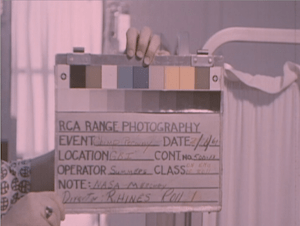 Chimp Recovery (RCA Service Co., 1961)
Chimp Recovery (RCA Service Co., 1961)
6 min., color, silent
Source: University of South Carolina Moving Image Research Collections
Recorded February 1, 1961, Chimp Recovery, is the title assigned to one of three rolls of unedited footage showing the first chimpanzee launched into orbit as part of Project Mercury, the American man-in-space mission. One roll, dated January 23, 1961, documents a medical examination of “astrochimp” no. 65. Upon his safe return to Patrick Air Force Base in Florida, NASA gave him the name Ham. A second roll (the DVD’s additional six minutes of footage, overscanned to reveal the 35mm film’s edges) shows a team of scientists preparing the chamber in which the chimp is sealed for his rocket flight on the Mercury-Redstone Launch Vehicle. The third, Chimp Recovery, was taken at a facility on Grand Bahama Island, and runs nearly eight minutes (edited to six on the DVD).
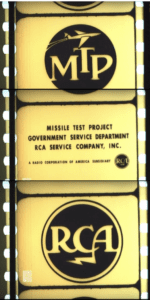
The University of South Carolina received the footage as part of the Paul Rubenstein Collection, donated by the Florida-based news cinematographer. RCA Service Company shot the film as part of the U.S. Air Force’s Missile Test Project (MTP). Started in the mid-1950s, the project — like many high-level military and intelligence endeavors — documented its work thoroughly, using full-service 35mm motion picture units and technical experts. By 1957, the RCAS MTP outfit in Florida included experienced cinematographers and directors, as well as editors, cutters, inspectors, sound recordists, lighting technicians, laboratory film processing staff, even a film librarian. In addition to clinical recordings, such as these, the unit made documentary, training, and public information films.
How these reels came to Rubenstein is undocumented, but not surprising. He was well connected in Florida and worked for CBS News covering the space program. Unclassified government films and raw footage flowed readily to media outlets. The National Archives, for example, holds several of NASA’s “unedited film reports” showing Mercury chimpanzees training, Ham’s launch and recovery (including animated sequences), and on-board footage of Ham during his flight. Nearly all of this readymade material appeared in newsreels and telecasts. With access to these public domain images of Ham, one can find an increasing number of amateur and professional uses of them on the Web. The more disturbing medical lab scenes have been used to illustrate works sympathetic to animal rights — notably David Cassidy and Kristin Davy’s documentary One Small Step: The Story of the Space Chimps (2003).
Preservation note by Heather Heckman and Greg Wilsbacher
Chimp Recovery is cataloged as RBSN 183 “Arrival, Examination, and Transfer–GBI” (808 feet). The DVD’s additional footage is RBSN 188 Countdown and Procedures (Animal and Subject) Capsule #5 (ca. 500 feet). All of the stock is unpreserved 35mm Eastman interpositive.
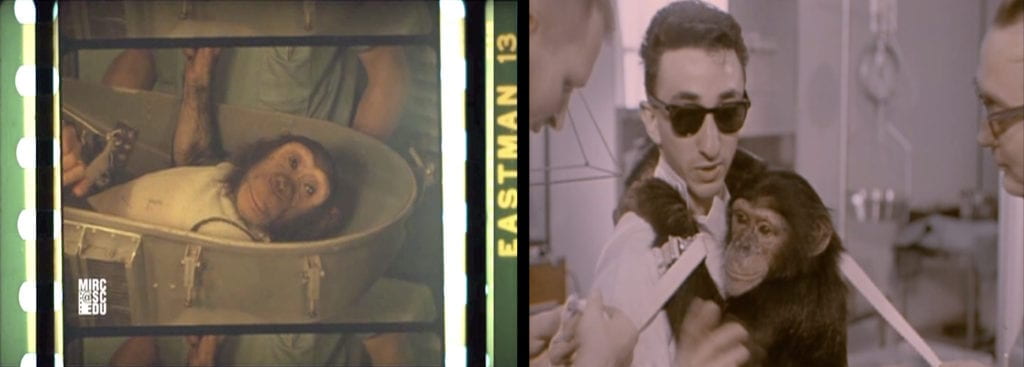
Notes on Chimpanzee no. 65
January 31, 2021, marked the 60th anniversary of Ham’s historic ascent into space. After a suborbital journey of just over 16 minutes, Project Mercury chimpanzee no. 65 splashed down to great fanfare. Upon his recovery, NASA announced that his name was Ham, after the Holloman Aerospace Medical Center in New Mexico, where the Air Force trained dozens of chimpanzees for the space program. Ham had a brief media celebrity, appearing in the press and on television. [See the performance of Lester Flatt’s 1961 bluegrass song “(They’re Gonna Put a)Monkey on the Moon” on Orphans in Space DVD.] He then disappeared from the public eye almost as quickly.
Reviewing the holdings of the nation’s film archives, a couple of things become apparent. First, judging by how much film was shot of the chimpanzees’ training and missions, the people involved knew they were building something important that would lead man to ride the great space ocean. Second, judging by how infrequently these same archived films have been viewed over the past four decades, the NASA missions of Ham, Enos, and the many other chimps who trained alongside them have been relegated to a footnote in the historic records.
In the footage seen on this DVD, Ham is sealed into a flight couch, which would later be inserted into a Mercury capsule. Ham is also shown with a variety of his handlers during medical check-ups. Even though Ham’s mission would be closely followed by Alan Shepard’s suborbital flight, the tale is told that the astronauts were not thrilled to have to follow chimpanzees into space. Later, however, the astronauts admitted to being impressed by the level of training the chimpanzees endured.
The government documents concerning these missions are mostly about the chimps’ reaction times and the physical stresses from the pressures of flight. With this in mind, we rely on motion-picture documentation like Chimp Recovery to understand more about the personality of Ham, who despite his simian heritage, was a prime player in this curious historical moment. The official reports fail to show us Ham’s personality. He was a young chimp who enjoyed the company of his trainers, especially Ed Dittmer who is seen in these films. Ham’s handlers, who I interviewed for my documentary, always considered him an affectionate and even-tempered little guy. What is striking about the raw footage seen here, is it shows the young chimp baring his teeth, which has never been the public image of Ham.
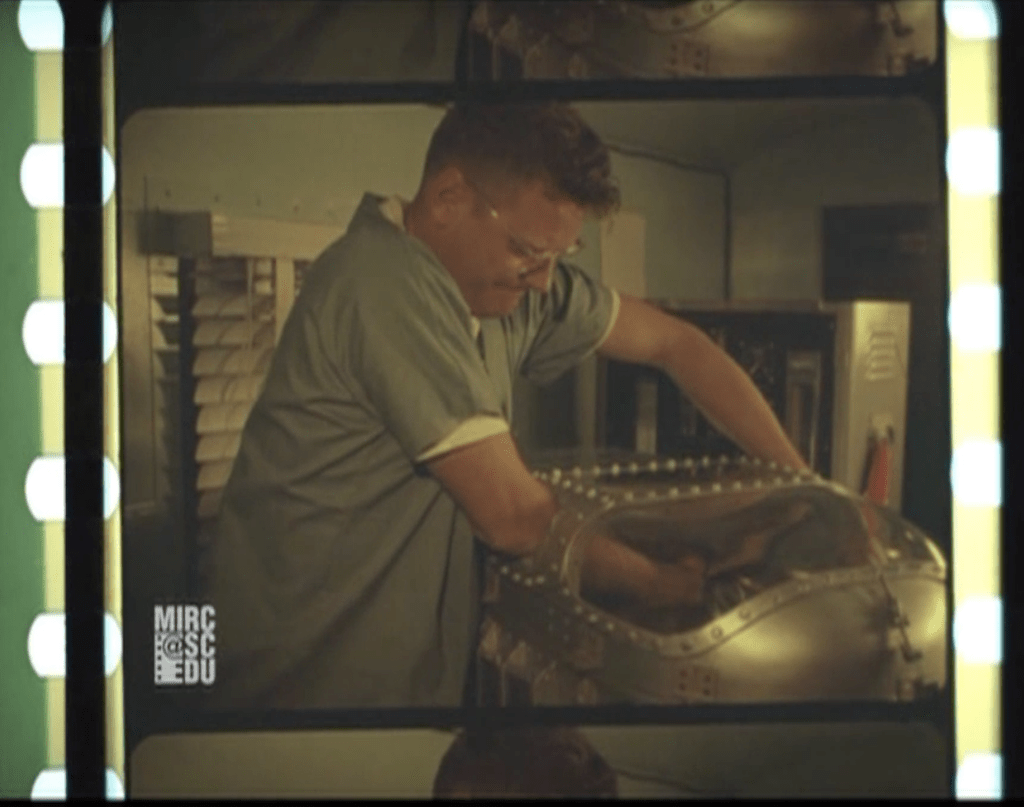
After the flight, Air Force and NASA personnel photographed Ham. The press reported that one of the most widely seen photos showed him grinning, happy with the anticipation of an apple. But primatologist Jane Goodall corrects the record in One Small Step, when she tells us “Actually, that is the most extreme fear that I’ve ever seen on any chimpanzee.”
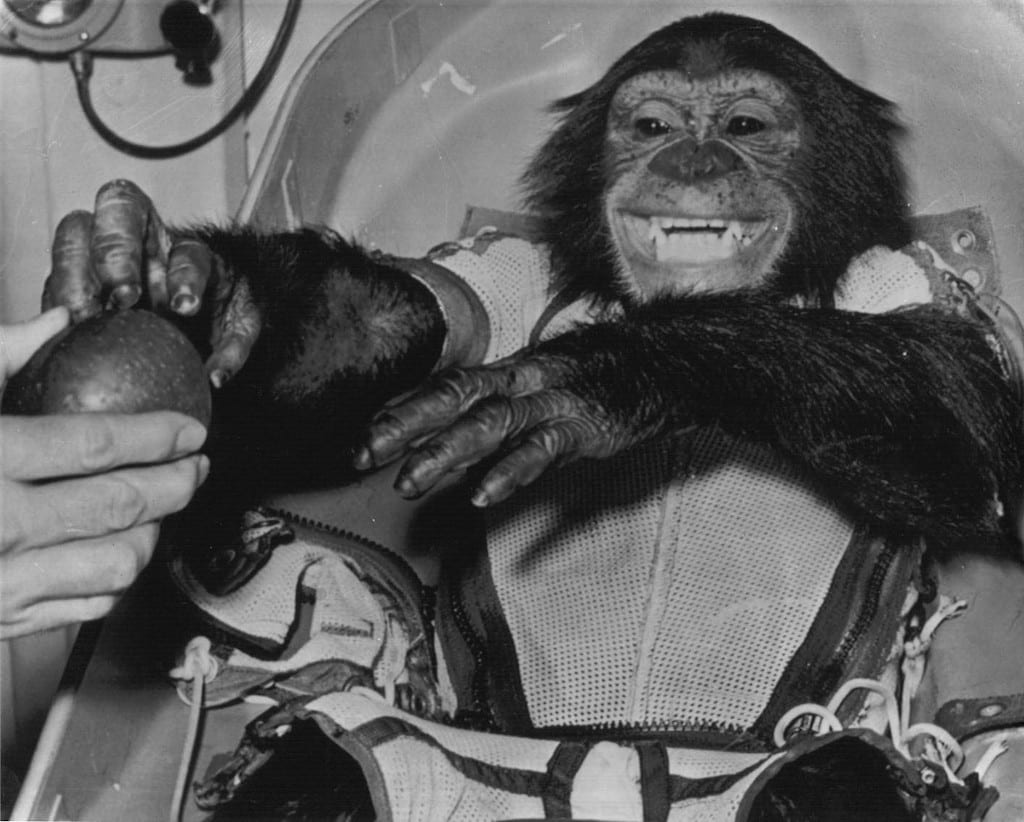
Ham was born in French Cameroon, July 1957, and died at the North Carolina Zoological Park, January 19, 1983.
—
David Cassidy is a documentary producer with Cabin Creek Films. A graduate of the University of Florida’s Documentary Institute, he co-directed One Small Step: The Story of the Space Chimps (2003), which explores the chimpanzees’ missions and their lives after leaving the public eye.
